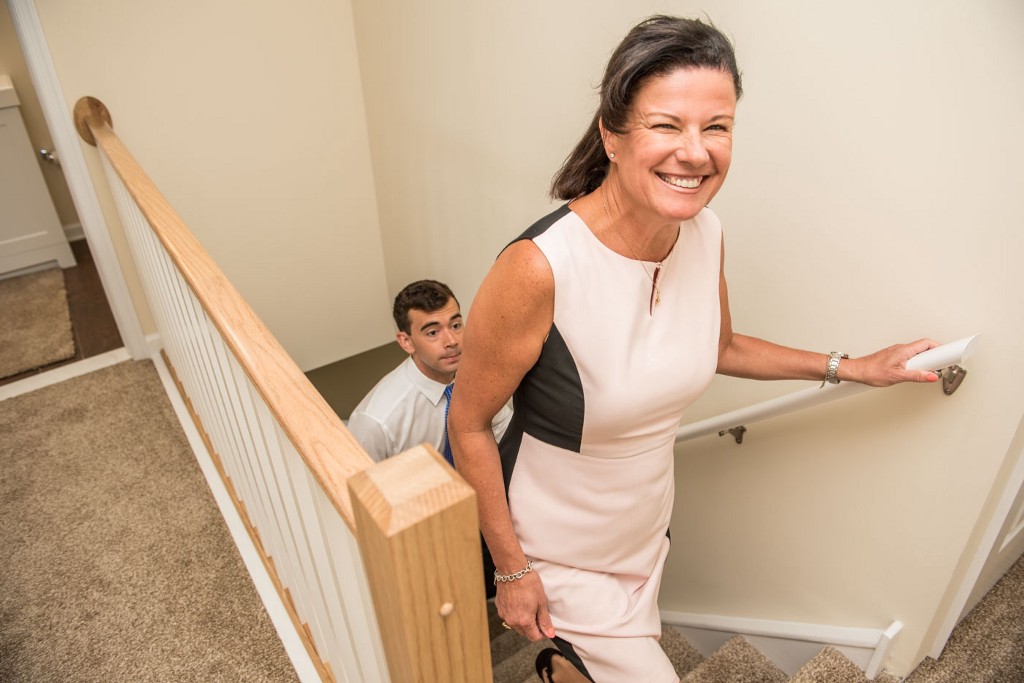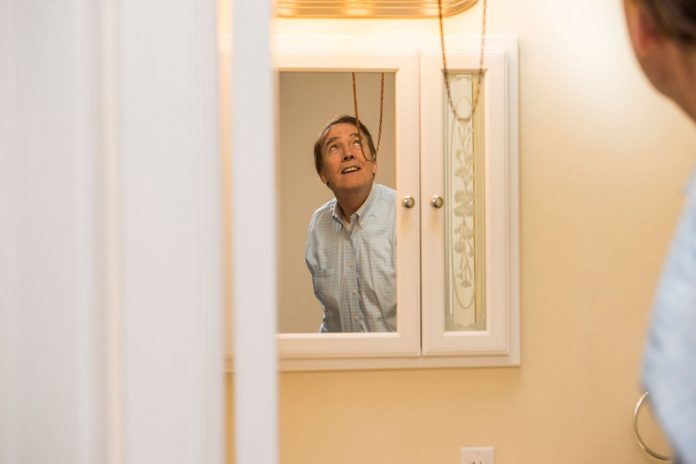Councilman Brian O’Neill looks at the skylight at the redeveloped property’s bathroom. (Maria S. Young)
Blighted property conservatorship isn’t just for community-based nonprofits anymore. The city is doing it now, too.
Last week, the Philadelphia Redevelopment Authority completed its first-ever conservatorship — the rehabilitation of an abandoned townhouse in Morrell Park. The project has cost taxpayers nothing and, officials hope, will be a catalyst for new private investment in existing housing stock in the neighborhood.
“Our traditional role has been (property) acquisition for affordable housing. This (project) is very different from our historic work,” said Brian Abernathy, executive director of the PRA, during a tour of the refurbished house at 3589 Nottingham Lane last Thursday. “As we’re evolving, we’re finding out how to not only redevelop neighborhoods, but also to protect already established neighborhoods. It’s easy for a house like this that’s vacant to become a cancer for the rest of the neighborhood.”
PRA is not a true branch of city government. It’s considered a quasi-city agency and was created by the state legislature in 1945. The mayor appoints the agency’s five-member board of directors, but the agency gets most of its funding from federal grants along with its own revenue-generating activities.
In contrast to its “traditional” role in the city’s poorer areas, PRA has been trying to expand its geographical impact lately. That’s why Abernathy visited City Councilman Brian O’Neill’s office a while back, to seek recommendations for projects in O’Neill’s 10th district. The Nottingham Lane house was among the first that came to mind.
“This was our first work in the councilman’s district in a long time. We’re trying to figure out how to provide assistance in different neighborhoods,” Abernathy said.
It’s also PRA’s first conservatorship, although several others are now in the pipeline.
“In the past we would have had to buy it (up front) or condemn it,” Abernathy said of the Nottingham Lane house.
Neighbors had been complaining to O’Neill about the place for a while. The owner had seemingly disappeared, leaving it for vandals, squatters and the local wildlife. The backyard, which abuts the Aria-Torresdale hospital campus, was a mess. The house was unsecured and exposed to the elements. There was no heat, so the pipes broke, causing major water damage. Rodents and insects infested the place. Kids used it as a party spot and left trash strewn from wall to wall, along with holes in the walls.
Adjoining residents feared for their safety, their quality of life and their own property values.
“This process started three or four years ago with my office,” O’Neill recalled. “We started trying to do things the traditional way. We contacted (Licenses and Inspection) for a clean and seal. We were asking for (them to install) things like windows and doors instead of plywood.”
Then Abernathy showed up looking for a conservatorship project.
Pennsylvania lawmakers passed the Abandoned and Blighted Property Conservatorship Act, also known as Act 135, in 2008. The Northeast’s Rep. John Taylor introduced the initial legislation. Under the law, a community stakeholder can apply to the courts to take possession of an abandoned property, rehabilitate it and sell it to cover expenses associated with the work. The conservator is also entitled to a portion of the proceeds.
As part of the process, the conservator must try to contact the property owner, who can reclaim the property. But in many cases, the owner doesn’t show up, perhaps because he owes more money on the property than it’s worth. For 3589 Nottingham, city records list David Gordon as the owner. He bought the place for a nominal $1 in 1982. Details of that sale are not known. PRA officials tried to contact him via registered letter but got no response. His relatives weren’t interested in the property, either.
Unlike many private sector conservators, PRA didn’t have to hire anyone to manage the rehab or contractors to do the work. The agency has its own project managers, tradesmen and laborers. It even has its own real estate broker to handle the listing and sale of the refurbished house. PRA had not listed the house or named a price as of early this week.
Following a fourth-month build out, the place is move-in ready with new wiring, walls, carpeting, fixtures, heating, air conditioning, kitchen and bathrooms. The basement is clean and ready for finishing work. There is a new stucco and vinyl exterior, energy efficient roof and wooden fence surrounding the backyard.
The house is 1,260 square feet and sits on a lot of 2,155 square feet. The 2016 assessment is $111,800 although the other houses on the block are mostly assessed between $165,000 and $175,000.
“It’s remarkable. This is a win-win for the neighborhood and for Northeast Philly because the neighborhood stays strong,” O’Neill said. “And it shows what can be done if somebody buys a real fixer-upper in the area.” ••

Mary Frances Fogg checks out the second floor of the redeveloped property on 3589 Nottingham Lane. (Maria Young)

Move-in ready: From left, Councilman Brian O’Neill, Mary Frances Fogg, the director of government relations at Philadelphia Redevelopment Authority, and Bobby Yerkov, O’Neill’s director of legislation, walk through a refurbished townhouse on Nottingham Lane in Morrell Park. The once-abandoned property was the Philadelphia Redevelopment Authority’s first-ever conservatorship. MARIA S. YOUNG / TIMES PHOTOS





